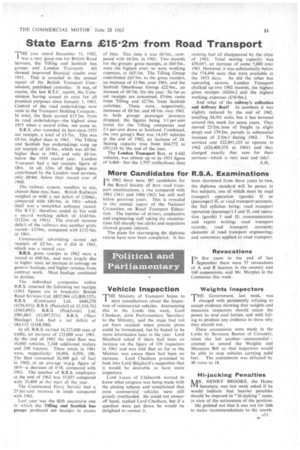State Earns £152m from Road Transport
Page 13

If you've noticed an error in this article please click here to report it so we can fix it.
THE year ended December 31. 1962. was a very good one for British Road Services, the Tilling and Scottish bus groups and London Transport. All showed improved financial results over 1961. This is revealed in the annual report of the British Transport Commission, published yesterday. It was, of course, the last B.T.C. report, the Commission having ceased to exist for all practical purposes since January I, 1963. Control of the road undertakings now vests in the Transport Holding Company. In total, the State earned £15.2m. from its road undertakings-the highest since 1955 when a record £16m, net came in.
B.R.S. also recorded its best-since-1955 net receipts, a total of £3-7m. This was £0.3m. higher than in 1961. The Tilling and Scottish bus undertakings rang up net receipts of £6-5m., which was £0-3m. higher than in 1961, and only £0.1m. below the 1959 record year. London Transport had a net receipts figure of £8m. In all, £5m. of that figure was contributed by the London road services, only £0.4m. below their record year of 1960.
The railway system, needless to say, altered these rosy hues. British Railways weighed in with a net deficit of £104m., compared with £86-9m. in 1961-which itself was a somewhat unhappy record. The B.T.C. therefore ended its life with a record working deficit of £143.6m. (E122m. in 1961). The overall revenue defic:t of the railway s was another grisly record-1 I 59m., compared with £1 35.9m. in 1961.
Commercial advertising scored net receipts of £2.3m., as it did in 1961, which was a record year.
!I.R.S. gross receipts in 1962 were a record at £60.3m.. and were largely due io higher rates. an increase in tonnage on general haulage, and higher revenue from contract work. Meat haulage continued to decline.
The individual companies within B.R.S. returned the following net receipts (1961 figures are in brackets): British Road Services Ltd. £837,966 (£1,009,337); B.R.S. (Contracts) Ltd. £440,270
(536,93 I); (Parcels)Ltd. C1,516,762 (£965,095); B.R.S. (Pickfords) Ltd. 1981,863 (11,097,571); B.R.S. (Meat Haulage) Ltd. had a Oct deficit of £84,113 (£168.300).
In all, B.R.S. tarried 16,223,000 tons of traffic, an increase of 123,000 over 1961. At the end of 1962 the total fleet was 16,040 vehicles, 7,348 additional trailers and 290 tractors. These totals in 1961 were, respectively: 16,066, 6,939, 196. The fleet consumed 26,909 gal. of fuel in 1962, at an average m.p.g. figure of 10-9-a decrease of 0.18, compared with 1961. The number of B.R.S. employees at the end of 1962 was 35,037 compared with 35,469 at the start of the year.
The Continental Ferry Service had a 27 per cent increase in loads compared with 1961.
Last year was the fifth successive one in which the Tilling and Scottish bus groups produced net receipts in excess
of £6m. This time it was £6-5m., compared with £6-2m. in 1961. Two records for the groups: gross receipts, at £68-3m.. were the highest ever; so were working expenses, at £631m. The Tilling Group contributed 145-5m. to the gross receipts, an increase of £1.9m. over 1961, and the Scottish Omnibuses Group £22.9m., an increase of £0-7m. for the year. So far as net receipts are concerned, 13-8m. came from Tilling and £2.7m. from Scottish activities. These were, respectively, increases of £0.3m. and i0-1m. over 1961. In both groups passenger journeys dropped, the figures being 3-1 per cent lower for the Tilling companies and 2.1 per cent down in Scotland. Combined. the two group's fleet was 14.195 vehicles at the end of 1962, an increase of 24. Seating capacity rose from 684,772 to 695.118 by the end of the year.
The London Transport fleet, at 8,442 vehicles, was almost up to its 1953 figure of 8,466hut the 1,797 trolleybuscs then
existing had all disappeared by the close of 1962. Total seating capacity was 470,085. an increase of some 5,000 over 1961. However it was substantially below the 574,496 scats that were available in the 1953 days. As did the other bus operating sectors, London Transport chalked up two 1962 records, the highest gross receipts (£62m.) and the highest working expenses (£56-9m.).
And what of the railway's collection and delivery fleet? In numbers it was slightly reduced by the end of 1962, totalling 34,561 units, but it has hovered around this mark for seven years. They moved 23-2m. tons of freight (a slight drop) and 179.2m. parcels (a substantial increase of 2.2m.) during 1962. The services cost £22.091,123 to operate in 1962 (24,408.358 in 1961) and they charged exactly that sum for their services-which is very neat and tidy!












































































































































